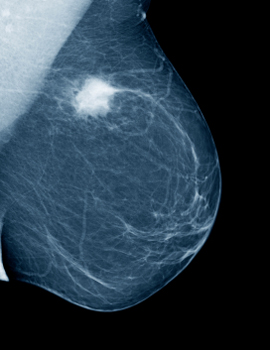 We’ve talked before how learning about breast cancer can feel like learning a new language. There are many different types, different stages, and different risk factors involved, but perhaps no single term is more confusing than one particularly confounding classification: triple negative breast cancer.
We’ve talked before how learning about breast cancer can feel like learning a new language. There are many different types, different stages, and different risk factors involved, but perhaps no single term is more confusing than one particularly confounding classification: triple negative breast cancer.
What is Triple Negative Breast Cancer?
In a nutshell, triple negative breast cancer is characterized by what it lacks: certain receptors on or within the cancerous cells that respond to estrogen, progesteroneA hormone that stimulates the uterus to prepare for pregnancy, produced mainly by the ovaries. Progesterone may play a role in certain breast cancers., or HER-2 (a kind of protein produced by a geneA sequence in the DNA which can be passed down from parent to child. Genes helps determine physical and functional traits for the body. also called HER-2).
Most types of breast cancers do possess protein receptors that will respond to one or more of these three different proteins. You may have heard a breast cancer described as “ER-positive;” that simply means it has receptors in or on its cells that respond to estrogenA female sex hormone that is primarily produced by the ovaries. Its primary function is to regulate the menstrual cycle and assist in the production of secondary sex characteristics such as breasts. It may even play a role in the production of cancer cells in the breast tissue.. Similarly, PR-positive breast cancer cells are sensitive to progesteroneA hormone that stimulates the uterus to prepare for pregnancy, produced mainly by the ovaries. Progesterone may play a role in certain breast cancers., and HER-2 positive breast cancers respond to HER-2 proteins. A breast cancer that does not possess any of these receptors in or on its cells, and is therefore is not “positive” to any of these three proteins, is known as triple negative.
Treatment of Triple Negative Breast Cancer
Triple negative breast cancer is considered aggressive and is more difficult to treat than other cancer types.
When a cancer’s growth rate can be effected by estrogenA female sex hormone that is primarily produced by the ovaries. Its primary function is to regulate the menstrual cycle and assist in the production of secondary sex characteristics such as breasts. It may even play a role in the production of cancer cells in the breast tissue. or progesteroneA hormone that stimulates the uterus to prepare for pregnancy, produced mainly by the ovaries. Progesterone may play a role in certain breast cancers. or HER-2 proteins, hormone-based therapies might be able to be used to slow or stop its growth.Triple negative breast cancer, since it is not sensitive to estrogenA female sex hormone that is primarily produced by the ovaries. Its primary function is to regulate the menstrual cycle and assist in the production of secondary sex characteristics such as breasts. It may even play a role in the production of cancer cells in the breast tissue., progesteroneA hormone that stimulates the uterus to prepare for pregnancy, produced mainly by the ovaries. Progesterone may play a role in certain breast cancers., or HER-2, is not responsive to hormone-based therapies that can be used to combat other types of breast cancer. However, triple negative breast cancer can be treated with chemotherapyTreatment with drugs to destroy or slow down the growth of cancer cells. Often referred to as systematic treatment, because it acts throughout the body, as opposed to localized treatments, like surgery or radiation. if necessary.
Triple Negative Breast Cancer Statistics
Triple negative breast cancer is uncommon, with only 10-15% of breast cancers falling into this category. It is more common among younger women, African-American and Hispanic women and women with the BRCA1 geneA sequence in the DNA which can be passed down from parent to child. Genes helps determine physical and functional traits for the body..
Triple Negative Breast Cancer Prognosis & Survival Rates
Triple negative breast cancer tends to have a worse prognosisThe expected or likely outcome of a disease, usually based on a statistical analysis of large groups of patients. than other forms of breast cancer. According to one 2012 study, women with triple negative breast cancer are almost three times as likely to die from their cancer than women with the most common forms of breast cancer. The same study reports women with triple negative breast cancer are 8.3 times more likely to die in the first two years of diagnosis than women diagnosed with other types of breast cancer. Cancer recurrenceThe reappearance of the disease after it has been treated. In breast cancer, recurrence following primary breast cancer can be local (in the same place), regional (in surrounding tissue) or metastatic (in some other part of the body). is also more frequent and happens earlier in those diagnosed with triple negative breast cancer.
Triple negative breast cancer can sound intimidating, and like all breast cancers, it’s scary. However, also like all breast cancers, the best defense against triple negative breast cancer is early detection! The sooner detection occurs and treatment begins, the better the prognosisThe expected or likely outcome of a disease, usually based on a statistical analysis of large groups of patients. will be. Monthly breast self-exams and yearly clinical breast exams or mammograms are essential in catching triple negative breast cancer at its earliest possible stage.
If you haven’t yet, sign up for our free Alarm Clock today, and never miss a chance to practice your best early detection habits against all kinds of breast cancer!